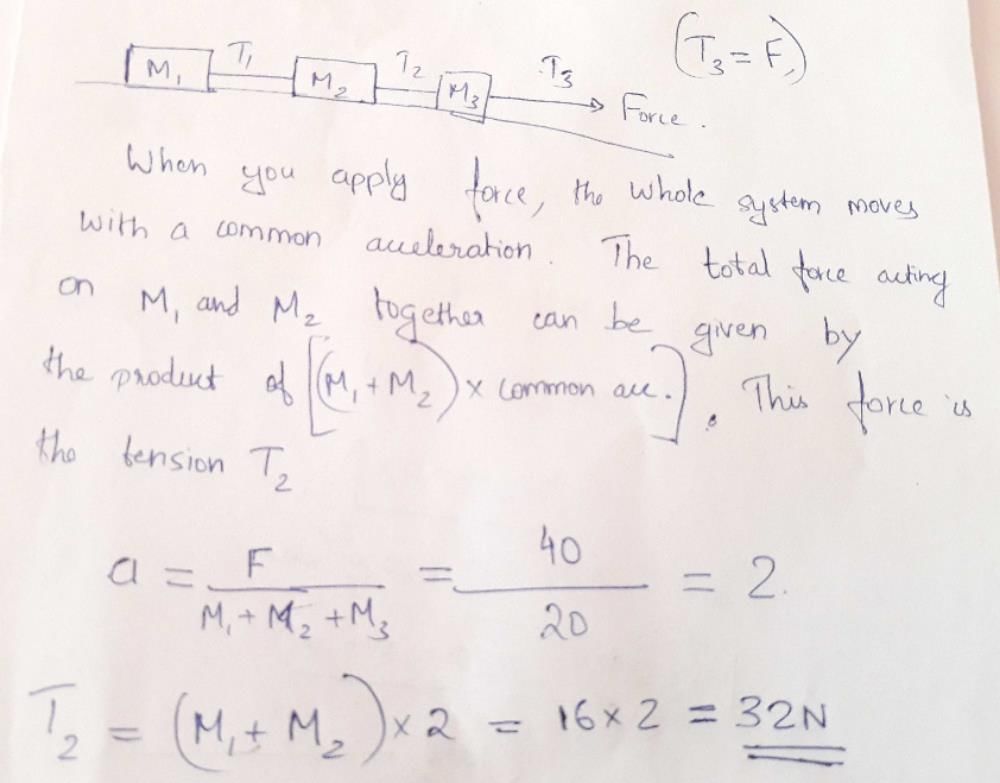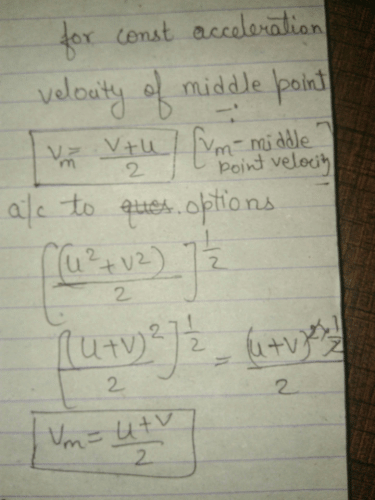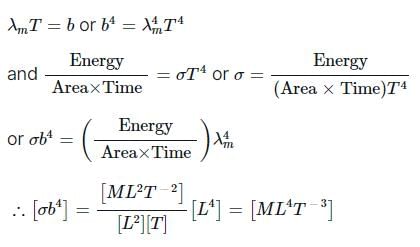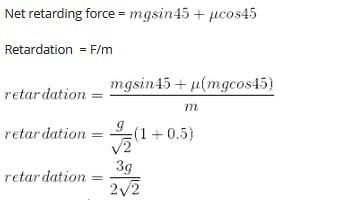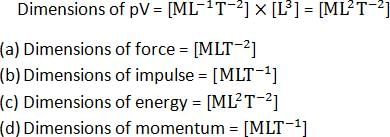All Exams >
NEET >
NEET Mock Test Series - Updated 2026 Pattern >
All Questions
All questions of Physics: Topic-wise Test for NEET Exam
The hight y and distance x along the horizontal plane of a projectile on a certain planet (With no surrounding atmosphere) are given as y=y=8t-5t2 mtr. and x = 6t metres, where t is in seconds. The velocity with which the projectile is projected is - a)8 m/s
- b)6 m/s
- c)10 m/s
- d)unpredictable
Correct answer is option 'C'. Can you explain this answer?
The hight y and distance x along the horizontal plane of a projectile on a certain planet (With no surrounding atmosphere) are given as y=y=8t-5t2 mtr. and x = 6t metres, where t is in seconds. The velocity with which the projectile is projected is
a)
8 m/s
b)
6 m/s
c)
10 m/s
d)
unpredictable

|
Adit Raj answered |
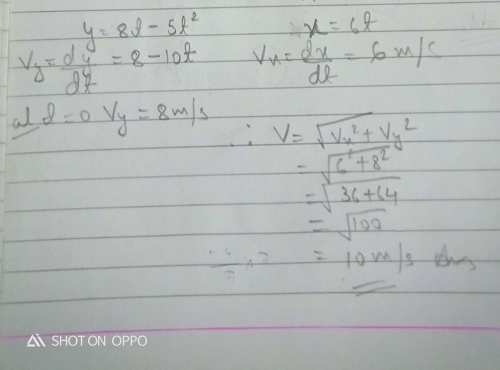
An athlete completes one round of a circular track of radius R in 40 seconds. The displacement at the end of 2 minutes 20 seconds is- a)0
- b)2R
- c)

- d)

Correct answer is option 'B'. Can you explain this answer?
An athlete completes one round of a circular track of radius R in 40 seconds. The displacement at the end of 2 minutes 20 seconds is
a)
0
b)
2R
c)
d)

|
Stepway Academy answered |
2 min 20 second = 140 second.
he completed one round in 40 second.
in 140 second, he will cover= 140/40=3.5 round.
after 3.5 round, he would be on the opposite side of the starting point.
So the displacement will be the diameter or 2R.
he completed one round in 40 second.
in 140 second, he will cover= 140/40=3.5 round.
after 3.5 round, he would be on the opposite side of the starting point.
So the displacement will be the diameter or 2R.
A man walks over a rough surface; the angle between force of friction and the instantaneous velocity of the person is
- a)π
- b)π/2
- c)2π
- d)zero
Correct answer is option 'D'. Can you explain this answer?
A man walks over a rough surface; the angle between force of friction and the instantaneous velocity of the person is
a)
π
b)
π/2
c)
2π
d)
zero
|
|
Anjali Iyer answered |
The correct option is D zero
Instantaneous velocity will be in forward direction.
Instantaneous velocity will be in forward direction.
When the man push the ground to move then its the friction which oppose the man from slipping so its the friction which help us to move on ground means the friction is in the direction of motion i.e., in forward direction.
So the angle is 00 means zero
Justification-
At smooth surfaces like that if an ice slab, when we push it to move forward our feet slip backward due to lack of forward friction.
A body slides down a smooth curved track which is one quadrant of a circle having radius 10 m. The speed of the body at the bottom of the track is:
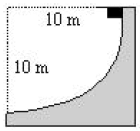
- a)

- b)10 m/s
- c)2 m/s
- d)None of these
Correct answer is option 'A'. Can you explain this answer?
A body slides down a smooth curved track which is one quadrant of a circle having radius 10 m. The speed of the body at the bottom of the track is:
a)
b)
10 m/s
c)
2 m/s
d)
None of these

|
Surya answered |
Yes option A is correct answer. u can get the answer by applying conservation of energy; KEf+PEf=KE+PE 1/2mv^2+0=0+mgh solve u get; v^2=2×g×h v=√2×10×10 v=√200 therefore. V=10√2 m/s....hope u clear...😊👍...
The rear side of a truck is open and a box of 40 kg mass is placed 5m away from the open end as shown in fig. The coefficient of friction between the box and the surface below it is 0.15. On a straight road, the truck starts from rest and accelerates with 2ms-2 . At what distance from the starting point does the box fall off the truck.
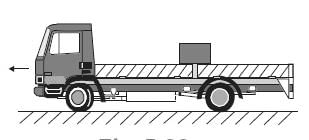
- a)4 m
- b)8 m
- c)16 m
- d)32 m
Correct answer is option 'C'. Can you explain this answer?
The rear side of a truck is open and a box of 40 kg mass is placed 5m away from the open end as shown in fig. The coefficient of friction between the box and the surface below it is 0.15. On a straight road, the truck starts from rest and accelerates with 2ms-2 . At what distance from the starting point does the box fall off the truck.

a)
4 m
b)
8 m
c)
16 m
d)
32 m

|
Sarthak Rajendra Bande answered |
A (net) of block = 0.5 m/s²
Now, s=0 + (1/2)at² and t is constant
so s is directly proportional to a
(4/x) =(0.5/2)
x=16m
So block will fall when truck is at at 16
An engine pumps up 100 kg of water through a height of 10m in 5 sec then if the efficiency of the engine os 60% then calculate the power of the engine where g = 10m/s- a)33 kW
- b)3.3 kW
- c)0.33 kW
- d)0.033 kW
Correct answer is option 'B'. Can you explain this answer?
An engine pumps up 100 kg of water through a height of 10m in 5 sec then if the efficiency of the engine os 60% then calculate the power of the engine where g = 10m/s
a)
33 kW
b)
3.3 kW
c)
0.33 kW
d)
0.033 kW
|
|
Rohan Singh answered |
Output power = mgh/t
= 100 kg x 10 m/s^2 x 10 m / 5 s
= 2 x 10^3 Watt
= 2 kW
Effeciency = [(Output power) / (Input power)] x 100
60 = [2 kW / (Input power)] x 100
Input power = 3.33 kW
Power of engine is 3.33 kW
A stone is projected upwards from the top of a building with some initial speed and reaches the ground in 5sec. Now it is allowed to fall with the same initial speed downwards and reaches the ground in 3 sec. If the stone is allowed to fall freely under gravity from the same point, it will reach the ground in- a)4 s
- b)2 s
- c)15 s
- d)8 s
Correct answer is option 'C'. Can you explain this answer?
A stone is projected upwards from the top of a
building with some initial speed and reaches the
ground in 5sec. Now it is allowed to fall with the
same initial speed downwards and reaches the
ground in 3 sec. If the stone is allowed to fall freely
under gravity from the same point, it will reach the
ground in
a)
4 s
b)
2 s
c)
15 s
d)
8 s

|
Lekshmi Banerjee answered |
In case of uniform circular motion which of the following physical quantities do not remain constant? - a)speed
- b)kinetic energy
- c)angular momentum
- d)momentum
Correct answer is option 'D'. Can you explain this answer?
In case of uniform circular motion which of the
following physical quantities do not remain
constant?
a)
speed
b)
kinetic energy
c)
angular momentum
d)
momentum

|
Aashika Packiaselvam answered |
Change in direction of velocity means the velocity is changing (no matter whether it's magnitude changes or not). So linear momentum is not a constant in circular motion. But it is possible to have a uniform acceleration in circular motion if we keep the rate of change in velocity is constant.
A physical quantity X is related to four observables a,b,c & d as follows  . The percentage error of measurement in a,b,c and d are 1%,3%,4% & 2% respectively, the percentage error in the quantity X is
. The percentage error of measurement in a,b,c and d are 1%,3%,4% & 2% respectively, the percentage error in the quantity X is - a)13%
- b)14%
- c)17%
- d)24%
Correct answer is option 'A'. Can you explain this answer?
A physical quantity X is related to four observables  . The
. The
a,b,c & d as follows
percentage error of measurement in a,b,c and d
are 1%,3%,4% & 2% respectively, the percentage
error in the quantity X is
a)
13%
b)
14%
c)
17%
d)
24%

|
Kavya Biradar answered |
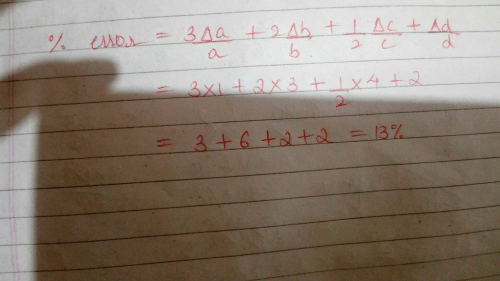
A block of mass 4 kg is placed on a rough horizontal plane. A time dependent force F = kt^2
acts on the block, where k = 2 N/s^2
Force of friction between block and the plane at t = 2 sec (given coefficient of friction is 0.3)- a)8N
- b)4N
- c)12N
- d)zero
Correct answer is option 'A'. Can you explain this answer?
plane. A time dependent force
F = kt^2
acts on the
block, where
k = 2 N/s^2
Force of friction between
block and the plane at t = 2 sec (given coefficient of friction is 0.3)
a)
8N
b)
4N
c)
12N
d)
zero
|
|
Rohit Shah answered |
F = kt^2
F = 2t^2 --- k = 2
Fmax = μmg
= (0.8) (4) (10)
= 32 N
applied force = F = 2t^2
at t = 2s, F = 2 (2)^2 = 8N
Hence body cannot move.
And force of friction between block and plane = applied farce = 8 N
A particle moves along a straight line such that its displacement at any time is given by 
 meters . Th e velocity when the acceleration is zero is
meters . Th e velocity when the acceleration is zero is - a)3

- b)-12

- c)42

- d)-9

Correct answer is option 'D'. Can you explain this answer?
A particle moves along a straight line such that its 

displacement at any time is given by
meters . Th e velocity when the
acceleration is zero is
a)
3 
b)
-12
c)
42
d)
-9
|
|
Rohan Singh answered |
Velocity, v= ds/dt=3t^2 -12 t+3
Acceleration a = ds/dt = 6t - 12; For a = 0 we have, 0 = 6 t - 12 or t= 2s. Hence, at t = 2 s the velocity will be
v = 3 X 22 – 12X 2 + 3 = -9 ms-1
A stone is dropped from a certain height which can reach the ground in 5 second. If the stone is stopped after 3 second of its fall and then allowed to fall again, then the time taken by the stone to reach the ground for the remaining distance is- a)2 sec
- b)3 sec
- c)4 sec
- d)None of these
Correct answer is option 'C'. Can you explain this answer?
A stone is dropped from a certain height which can reach the ground in 5 second. If the stone is stopped after 3 second of its fall and then allowed to fall again, then the time taken by the stone to reach the ground for the remaining distance is
a)
2 sec
b)
3 sec
c)
4 sec
d)
None of these

|
Prakhar Maheshwari answered |
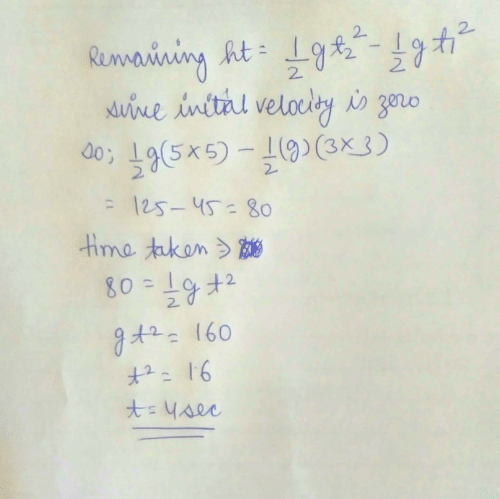
The minimum acceleration that must be imparted to the cart in figure given so that the block A will bot fall, given µ is the coefficient of friction between the surface of block and cart 
- a)

- b)

- c)

- d)

Correct answer is option 'B'. Can you explain this answer?
The minimum acceleration that must be imparted
to the cart in figure given so that the block A will
bot fall, given µ is the coefficient of friction
between the surface of block and cart
a)
b)
c)
d)
|
|
Geetika Shah answered |
uN = mg
N = ma
u ma = mg
N = ma
u ma = mg
a = g/u
A block of mass 4 kg is suspended through two light spring balances A and B. Then A and B will read __respectively 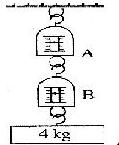
- a)4 kg and zero kg
- b)zero kg and 4 kg
- c)4 kg and 4 kg
- d)2 kg and 2 kg
Correct answer is option 'C'. Can you explain this answer?
A block of mass 4 kg is suspended through two
light spring balances A and B. Then A and B will
read __respectively
a)
4 kg and zero kg
b)
zero kg and 4 kg
c)
4 kg and 4 kg
d)
2 kg and 2 kg
|
|
Rohit Jain answered |
As the spring balances are massless therefore the reading of both balance should be equal.
Pick the incorrect statement- a)average speed of a particle in a given time is never less than the magnitude of average velocity
- b)It is possible to have situation in which

- c)the average velocity of a particle is zero in a time interval. It is possible that instantaneous velocity is never zero in that inerval.
- d)the average velocity of a particle moving on a straight line is zero in a time interval. It is possible that the instantaneous velocity is never zero in the interval. Infinite accelerations are not allowed
Correct answer is option 'D'. Can you explain this answer?
Pick the incorrect statement
a)
average speed of a particle in a given time is
never less than the magnitude of average
velocity
b)
It is possible to have situation in which
c)
the average velocity of a particle is zero in a
time interval. It is possible that instantaneous
velocity is never zero in that inerval.
d)
the average velocity of a particle moving on a
straight line is zero in a time interval. It is
possible that the instantaneous velocity is never
zero in the interval. Infinite accelerations are
not allowed

|
Adit Raj answered |
Option D
example -free electron in a conductor
its avg velocity is zero but instantaneous velocity is nonzero
A particle collides with another particle such that the second particle starts moving and the first particle stops just after the collision. Then which of the following conditions must always be valid? (m/M = ratio of masses)- a)

- b)m/M = 1
- c)e = 1
- d)e < 1
Correct answer is option 'A'. Can you explain this answer?
A particle collides with another particle such that the
second particle starts moving and the first particle
stops just after the collision. Then which of the
following conditions must always be valid? (m/M =
ratio of masses)
a)
b)
m/M = 1
c)
e = 1
d)
e < 1

|
Ayush Sengupta answered |
A parachutist of weight W strikes the ground with his legs fixed and comes to rest with an upward acceleration of magnitude 3g . force exerted on him by ground during landing is- a)1 W
- b)2W
- c)3W
- d)4W
Correct answer is option 'D'. Can you explain this answer?
A parachutist of weight W strikes the ground with
his legs fixed and comes to rest with an upward
acceleration of magnitude 3g . force exerted on
him by ground during landing is
a)
1 W
b)
2W
c)
3W
d)
4W
|
|
Rajeev Saxena answered |
Mg = W N - W = 3mg N - W = 3W N = 3W + W N = 4W
A 15 kg mass is accelerated from rest with a force of 100 N. As it moves faster, friction & air resistance create an oppositely directed retarding force given by FR = A+BV. where A=25 N and B= 0.5 Ns/milter. At what velocity does the acceleration equal to one half of the initial acceleration ?- a)25 m/s-1
- b)50 m/s-1
- c)75 m/s-1
- d)100 m/s-1
Correct answer is option 'C'. Can you explain this answer?
A 15 kg mass is accelerated from rest with a force of 100 N. As it moves faster, friction & air resistance create an oppositely directed retarding force given by FR = A+BV. where A=25 N and B= 0.5 Ns/milter. At what velocity does the acceleration equal to one half of the initial acceleration ?
a)
25 m/s-1
b)
50 m/s-1
c)
75 m/s-1
d)
100 m/s-1

|
Adit Raj answered |
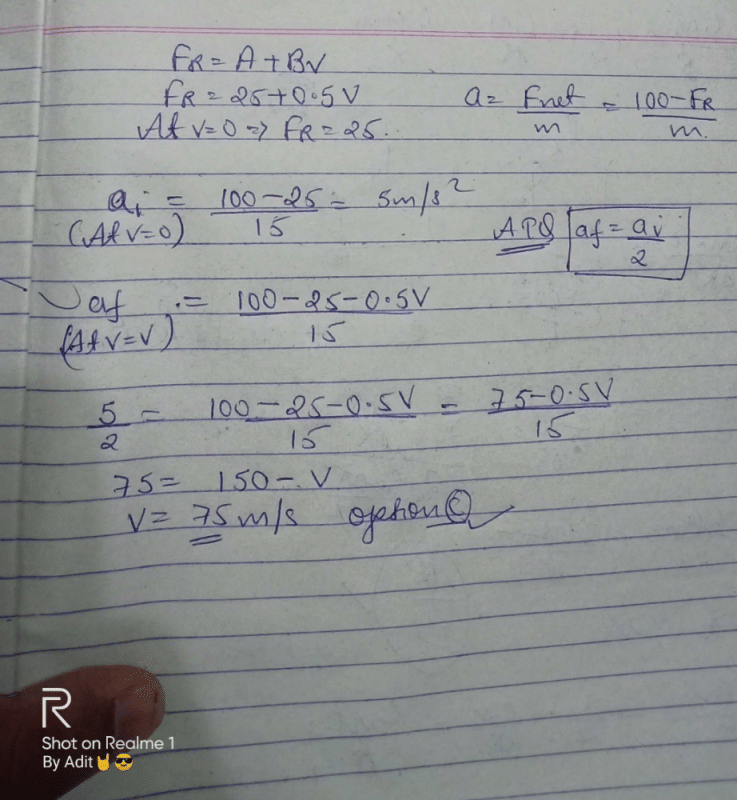
A heavy uniform chain lies on a horizontal table top. If the coefficient of friction between the chain and the table surface is 0.25, then the maximum fraction of the length of the chain, that can hang over one edge of the table is- a)20 %
- b)25 %
- c)35 %
- d)15 %
Correct answer is option 'A'. Can you explain this answer?
A heavy uniform chain lies on a horizontal table top.
If the coefficient of friction between the chain and
the table surface is 0.25, then the maximum fraction
of the length of the chain, that can hang over one
edge of the table is
a)
20 %
b)
25 %
c)
35 %
d)
15 %

|
Sushant Goyal answered |
The blocks of mass M1 and M2 are connected to each other through a light spring as shown in figure. If we push mass M1 with a force of F and cause acceleration a in mass M1, what will be the acceleration in M2:
- a)F/M2
- b)F/(M1+M2)
- c)a
- d)(F-M1a)/M2
Correct answer is option 'D'. Can you explain this answer?
The blocks of mass M1 and M2
are connected to each
other through a light spring as shown in figure. If
we push mass M1
with a force of F
and cause acceleration a
in mass M1
, what will be the acceleration in M2:a)
F/M2
b)
F/(M1+M2)
c)
a
d)
(F-M1a)/M2

|
Akshat Chavan answered |
An unloaded car moving with velocity u on a road can be stopped in a distance s. If passengers add 40% to its weight and braking force remains the same, the stopping distance at velocity u is now- a)1.4 s
- b)

- c)

- d)1/1.4 s
Correct answer is option 'A'. Can you explain this answer?
An unloaded car moving with velocity u on a road
can be stopped in a distance s. If passengers add
40% to its weight and braking force remains the
same, the stopping distance at velocity u is now
a)
1.4 s
b)
c)
d)
1/1.4 s

|
Subhankar Datta answered |
A helicopter flying at 20 m/s horizontally drops a rescue bag. Ignoring air resistance & taking g = 10 , the displacement of the bag 5 seconds after the drop began is nearly
, the displacement of the bag 5 seconds after the drop began is nearly - a)100 m
- b)125 m
- c)160 m
- d)225 m
Correct answer is option 'C'. Can you explain this answer?
A helicopter flying at 20 m/s horizontally drops a 
rescue bag. Ignoring air resistance & taking g = 10
, the displacement of the bag 5 seconds after the
drop began is nearly
a)
100 m
b)
125 m
c)
160 m
d)
225 m
|
|
Saumya Banerjee answered |
And assuming the bag falls vertically, the bag will accelerate downwards at a rate of 9.8 m/s^2 (acceleration due to gravity).
Using the formula for distance traveled under constant acceleration:
d = 1/2at^2
where d is the distance, a is the acceleration, and t is the time,
we can calculate the time it takes for the bag to reach the ground:
d = 1/2at^2
d = 1/2(9.8)(t^2)
d = 4.9t^2
When the bag is dropped, it has an initial velocity of 0 m/s in the vertical direction. The final velocity when it hits the ground will be the maximum velocity it reaches due to gravity, which we can calculate using the formula:
vf = vi + at
where vf is the final velocity, vi is the initial velocity, a is the acceleration, and t is the time.
Since the bag is dropped from rest, vi = 0, so:
vf = at
vf = 9.8t
We can now use the fact that the horizontal velocity of the helicopter does not affect the vertical motion of the bag, and the time it takes for the bag to fall to the ground is the same as the time it takes for the helicopter to travel a horizontal distance of 20 meters.
Using the formula for distance traveled at constant velocity:
d = vt
where d is the distance, v is the velocity, and t is the time,
we can solve for t:
20 = 20t
t = 1 second
Therefore, the bag will hit the ground after 1 second of falling, and its final velocity will be:
vf = 9.8(1)
vf = 9.8 m/s
Note that if the bag were dropped from a higher altitude, it would take longer to reach the ground and would have a higher final velocity due to the longer time of acceleration.
Using the formula for distance traveled under constant acceleration:
d = 1/2at^2
where d is the distance, a is the acceleration, and t is the time,
we can calculate the time it takes for the bag to reach the ground:
d = 1/2at^2
d = 1/2(9.8)(t^2)
d = 4.9t^2
When the bag is dropped, it has an initial velocity of 0 m/s in the vertical direction. The final velocity when it hits the ground will be the maximum velocity it reaches due to gravity, which we can calculate using the formula:
vf = vi + at
where vf is the final velocity, vi is the initial velocity, a is the acceleration, and t is the time.
Since the bag is dropped from rest, vi = 0, so:
vf = at
vf = 9.8t
We can now use the fact that the horizontal velocity of the helicopter does not affect the vertical motion of the bag, and the time it takes for the bag to fall to the ground is the same as the time it takes for the helicopter to travel a horizontal distance of 20 meters.
Using the formula for distance traveled at constant velocity:
d = vt
where d is the distance, v is the velocity, and t is the time,
we can solve for t:
20 = 20t
t = 1 second
Therefore, the bag will hit the ground after 1 second of falling, and its final velocity will be:
vf = 9.8(1)
vf = 9.8 m/s
Note that if the bag were dropped from a higher altitude, it would take longer to reach the ground and would have a higher final velocity due to the longer time of acceleration.
A man sits on a chair supported by a rope passing over a friction less fixed pulley. The man who weights 1000N exerts a force of 450 N on the chair downwards while pulling on the rope. If the chair weight 250 N and g is 10 ms-2, then the acceleration of the chair is- a)0.45 ms-2
- b)zero
- c)2ms-2
- d)9/25 ms-2
Correct answer is option 'C'. Can you explain this answer?
A man sits on a chair supported by a rope passing over a friction less fixed pulley. The man who weights 1000N exerts a force of 450 N on the chair downwards while pulling on the rope. If the chair weight 250 N and g is 10 ms-2, then the acceleration of the chair is
a)
0.45 ms-2
b)
zero
c)
2ms-2
d)
9/25 ms-2

|
Mehul Iyer answered |
When the angular velocity of a uniformly rotating body has increased thrice, the resultant of forces applied to it increase by 60 N. Find the acceleration of the body in the two cases. The mass of the body, m=3kg- a)2.5
 , 7.5
, 7.5 
- b)7.5
 , 22.5
, 22.5 
- c)5
 , 45
, 45 
- d)2.5
 , 22.5
, 22.5 
Correct answer is option 'D'. Can you explain this answer?
When the angular velocity of a uniformly rotating
body has increased thrice, the resultant of forces
applied to it increase by 60 N. Find the acceleration
of the body in the two cases. The mass of the
body, m=3kg
a)
2.5
, 7.5
b)
7.5
, 22.5
c)
5
, 45
d)
2.5
, 22.5
|
|
Dipanjan Malik answered |
Given:
m = 3 kg (mass of the body)
Let the initial angular velocity of the body be w1 and the final angular velocity be w2.
Let the initial resultant force applied be F1 and the final resultant force be F2.
Formula used:
For a uniformly rotating body, the angular velocity is given by: w = v/r, where v is the tangential velocity and r is the radius of rotation.
The tangential acceleration of a rotating body is given by: a = rα, where α is the angular acceleration.
The resultant force acting on a body is given by: F = ma, where m is the mass of the body and a is the acceleration.
Calculation:
Let the initial angular velocity be w1.
So, the initial tangential velocity v1 = r*w1
Let the final angular velocity be w2.
So, the final tangential velocity v2 = r*w2
First case:
Initial angular velocity = w1
Final angular velocity = 3*w1
So, the final tangential velocity is v2 = r*(3*w1) = 3*(r*w1) = 3*v1
Acceleration in this case:
Tangential acceleration = (v2 - v1)/t, where t is the time taken to increase the angular velocity from w1 to 3*w1.
Since the body is uniformly rotating, the time taken to increase the angular velocity is the same as the time taken for one rotation.
So, t = 2*pi*r/v1
Substituting the values of v1 and t, we get:
Tangential acceleration = (3*v1 - v1)/(2*pi*r/v1) = 2*v1^2/(pi*r)
Resultant force in this case:
The final resultant force is F2 = m*a = 3*2*v1^2/(pi*r) = 6*v1^2/(pi*r)
Second case:
Initial angular velocity = w1
Final angular velocity = 3*w1
The final resultant force is increased by 60 N.
So, F2 = F1 + 60
Acceleration in this case:
Using the formula F = ma, we get:
m*a = F2 = F1 + 60
Substituting the values of F1 and F2, we get:
3*a = a + 60/3
2*a = 20
a = 10 m/s^2
So, the initial acceleration is a = 2.5 m/s^2 and the final acceleration is a = 3*2.5 = 7.5 m/s^2.
Therefore, option D is the correct answer.
m = 3 kg (mass of the body)
Let the initial angular velocity of the body be w1 and the final angular velocity be w2.
Let the initial resultant force applied be F1 and the final resultant force be F2.
Formula used:
For a uniformly rotating body, the angular velocity is given by: w = v/r, where v is the tangential velocity and r is the radius of rotation.
The tangential acceleration of a rotating body is given by: a = rα, where α is the angular acceleration.
The resultant force acting on a body is given by: F = ma, where m is the mass of the body and a is the acceleration.
Calculation:
Let the initial angular velocity be w1.
So, the initial tangential velocity v1 = r*w1
Let the final angular velocity be w2.
So, the final tangential velocity v2 = r*w2
First case:
Initial angular velocity = w1
Final angular velocity = 3*w1
So, the final tangential velocity is v2 = r*(3*w1) = 3*(r*w1) = 3*v1
Acceleration in this case:
Tangential acceleration = (v2 - v1)/t, where t is the time taken to increase the angular velocity from w1 to 3*w1.
Since the body is uniformly rotating, the time taken to increase the angular velocity is the same as the time taken for one rotation.
So, t = 2*pi*r/v1
Substituting the values of v1 and t, we get:
Tangential acceleration = (3*v1 - v1)/(2*pi*r/v1) = 2*v1^2/(pi*r)
Resultant force in this case:
The final resultant force is F2 = m*a = 3*2*v1^2/(pi*r) = 6*v1^2/(pi*r)
Second case:
Initial angular velocity = w1
Final angular velocity = 3*w1
The final resultant force is increased by 60 N.
So, F2 = F1 + 60
Acceleration in this case:
Using the formula F = ma, we get:
m*a = F2 = F1 + 60
Substituting the values of F1 and F2, we get:
3*a = a + 60/3
2*a = 20
a = 10 m/s^2
So, the initial acceleration is a = 2.5 m/s^2 and the final acceleration is a = 3*2.5 = 7.5 m/s^2.
Therefore, option D is the correct answer.
A particle of mass m is driven by a machine that delivers a constant power k watts. If the particle starts from rest the force on the particle at time t is- a)

- b)

- c)

- d)

Correct answer is option 'A'. Can you explain this answer?
A particle of mass m is driven by a machine that delivers a constant power k watts. If the particle starts from rest the force on the particle at time t is
a)

b)

c)

d)

|
|
Dev Patel answered |
Constant power acting on the particle of mass m is k watt.
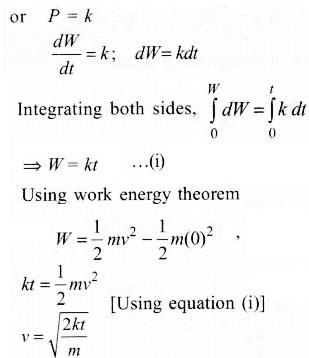
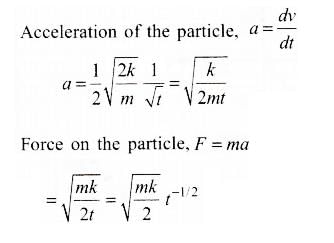
A person aims a gun at a bird from a point, at a horizontal distance of 100 m.If gun can impart a speed of 500m/s to the bullet,at what height above the bird must he aim his gun in order to hit it? (g = 10  )
) - a)10 cm
- b)20 cm
- c)50 cm
- d)100 cm
Correct answer is option 'B'. Can you explain this answer?
A person aims a gun at a bird from a point, at a 
horizontal distance of 100 m.If gun can impart a
speed of 500m/s to the bullet,at what height above
the bird must he aim his gun in order to hit it?
(g = 10
)
a)
10 cm
b)
20 cm
c)
50 cm
d)
100 cm

|
Ishaan Menon answered |
A balloon has 5gm of air. A small hole is pierced into it, the air escapes at a uniform rate with a velocity of 4cm/sec. If the balloon shrinks completely in 2.5 second, the mean force acting on the balloon is- a)2 dynes
- b)50 dynes
- c)8 dynes
- d)8 N
Correct answer is option 'C'. Can you explain this answer?
A balloon has 5gm of air. A small hole is pierced
into it, the air escapes at a uniform rate with a
velocity of 4cm/sec. If the balloon shrinks completely
in 2.5 second, the mean force acting on the balloon is
a)
2 dynes
b)
50 dynes
c)
8 dynes
d)
8 N

|
Devansh Mehra answered |
The sum & differences of two perpendicular vectors of equal magnitudes are- a)also perpendicular and of equal lengths
- b)also perpendicular and of different lengths
- c)of equal length and have an obtuse angle between them
- d)of equal lengths and have and acute angle between them
Correct answer is option 'A'. Can you explain this answer?
The sum & differences of two perpendicular
vectors of equal magnitudes are
a)
also perpendicular and of equal lengths
b)
also perpendicular and of different lengths
c)
of equal length and have an obtuse angle between
them
d)
of equal lengths and have and acute angle between
them

|
Prasenjit Pillai answered |
Which of the following statements is false ?- a)force of friction is independent of mecroscopic area of the surface in contact
- b)force of friction depends on the nature of materials of the surfaces in contact(i.e., force of adhension)
- c)force of friction does not depends on the relative velocity between the surfaces
- d)force of friction is independent of roughness or smoothness of the surfaces in contact
Correct answer is option 'D'. Can you explain this answer?
Which of the following statements is false ?
a)
force of friction is independent of mecroscopic area of the surface in contact
b)
force of friction depends on the nature of materials of the surfaces in contact(i.e., force of adhension)
c)
force of friction does not depends on the relative velocity between the surfaces
d)
force of friction is independent of roughness or smoothness of the surfaces in contact

|
Shanaya Rane answered |
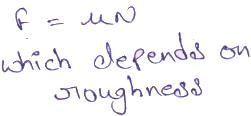
Chapter doubts & questions for Physics: Topic-wise Test - NEET Mock Test Series - Updated 2026 Pattern 2025 is part of NEET exam preparation. The chapters have been prepared according to the NEET exam syllabus. The Chapter doubts & questions, notes, tests & MCQs are made for NEET 2025 Exam. Find important definitions, questions, notes, meanings, examples, exercises, MCQs and online tests here.
Chapter doubts & questions of Physics: Topic-wise Test - NEET Mock Test Series - Updated 2026 Pattern in English & Hindi are available as part of NEET exam.
Download more important topics, notes, lectures and mock test series for NEET Exam by signing up for free.

Contact Support
Our team is online on weekdays between 10 AM - 7 PM
Typical reply within 3 hours
|
Free Exam Preparation
at your Fingertips!
Access Free Study Material - Test Series, Structured Courses, Free Videos & Study Notes and Prepare for Your Exam With Ease

 Join the 10M+ students on EduRev
Join the 10M+ students on EduRev
|

|
Create your account for free
OR
Forgot Password
OR
Signup to see your scores
go up within 7 days!
Access 1000+ FREE Docs, Videos and Tests
Takes less than 10 seconds to signup



